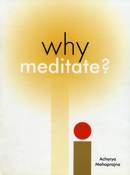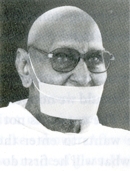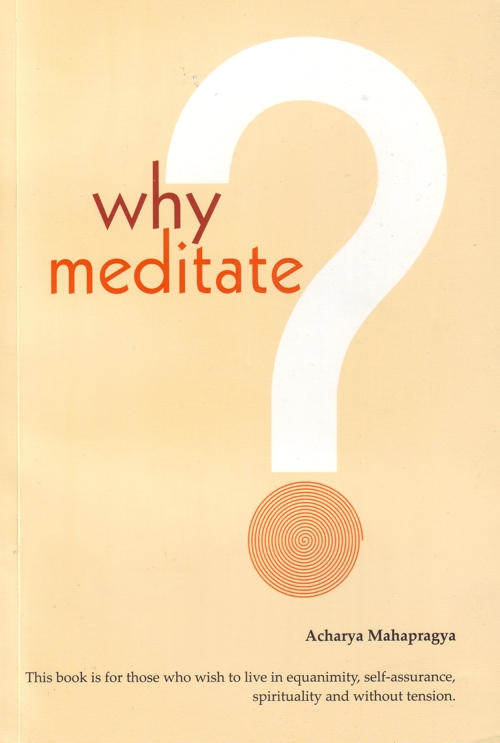

The ultimate goal of Preksha meditation is self-realization. All the halts and breaks along the way are not the destination. We have to reach the Self (soul). We practised perception of breath but breath is not the soul. We practised perception of the body, but the body is not the soul. We undertook an internal journey but that, too, is not the soul. These are the stepping-stones to reach our ultimate goal, which is realization of the Self (soul).
There may be a question as to why we perceive breath, vibration of vital force in the body and meditate on colours when we have to realize the soul. Instead, should we not perceive the soul directly? This question is natural. The answer is not difficult; in fact, it is very simple. If anyone wants to enter the meditation hall of Preksha Vishva Bharti, what will he first do to reach there? First, he should pass through the main entrance of Preksha Vishva Bharti, walk a little, open the main door and then enter the hall. No one can leap directly into the main hall. Similarly, if we have to realize the soul, we need to pass through the different gateways to reach there.
Our body is a gateway to the soul. From the standpoint of spiritual practice, the body is more important than the soul. Take an example of a pot filled with water. You are thirsty; drinking the water quenches your thirst. But the question arises whether the pot is more important than the water! Definitely, the water is more valuable than the pot but without a receptacle, how can the water be contained? We cannot ignore the importance of the receptacle. The receptacle has its own place, and that which is contained within it also has its importance. The pot is the receptacle and the water is contained in it. Similarly, the body is the receptacle and the soul resides in it. If we break the pot, how can we get water? A thirsty person first looks at the pot and then the water. From afar he can only see the pot, but to see water he needs to get closer. In the same way, our body is the pot in which the soul, the consciousness reside, like water.
We should perceive our body because without its perception, the soul cannot be realized. The breath is an integral part of the body. We cannot separate breath from the body. Perception is an art. One who knows to perceive can reach his goal. One who does not know the art of perception cannot reach his destination. Bharat Chakravarti went to take a shower. After taking a bath, he sat down to dress. His palace was made of glass. He sat in front of the mirror and started looking at himself. He was so engrossed in looking at his own beauty that he forgot to go to court to administer his kingdom. There come some moments in our lives, which suddenly transform our consciousness. He kept on looking at his face in the mirror. He would have seen his face many times, but on that particular day, his perspective was changed.
There is a special practice in yoga Sadhna, which involves focusing on one's own face in the mirror. It is a very important and beneficial practice. First, you concentrate on your face, its colour and features.
If you meditate on it, your entire aura will change; your perspective will also change. You will visualize a beautiful inner world, which you have never seen before. Although you will be looking outside, your vision will seem to vanish. It is written thus in Agam: Attaanam pehemaane pehemaane - that means, by perceiving and concentrating deeply on his face, Bharat Chakravarti attained self-realization and got enlightenment.
Bharat Chakravarti was so deeply engrossed in the perception of his body that he attained Keval Gyan [enlightenment, omniscience]. Some historians say that while looking at his ring, he attained Keval Gyan. In my opinion, this story might have been added during a later period. In Agam literature, it is stated that Bharat Chakravarti attained Keval Gyan by meditating on his face in the mirror.
Let us witness ourselves by perceiving our body. The perception of the body is very important because the soul resides in the body, the psyche is in the body, and the aura surrounds our body. We should perceive our body in a new perspective. In my opinion, the perception of the body is the initial stage of meditation. It is not a special practice but a method of retention. While perceiving the body, if you stop and focus at a particular point it becomes meditation, while if you go on perceiving your whole body it is retention.
A great seer, Patanjali has beautifully described three terms - Dharana (retention), Dhyan (meditation), Samadhi (trance - a state of self realization). The very first stage is Dharana. Deshbandhan cittasya dharana means focusing the psyche at a particular point or place. The attunement that results as a consequence of centring the psyche at a point is called meditation.
The second stage of perception of the body is a special kind of meditation i.e. Chaitanya Kendra Preksha [perception of the psychic centres]. There are some marmasthaan (vital centres) in our body.
In Ayurveda, many vital centres have been mentioned. According to Sushrut there are more than 150 vital centres in the human body. Acharya Mallisen has defined these very clearly in Syadvaad Manjari: Bahubhiraatmapradeshairadhishthitaa dehaavayavaah marma. The places where the soul manifests are known as marma (vital centre). The soul pervades throughout the body. But there are innumerable domains of the soul, where the manifestation of the soul may be intense or compact. A space occupied by a point can accommodate thousands and Lakhs of domains of soul, while at some other point, they are sparse. The water of the river flows in abundance at some places and is scattered at some spots. Similarly, the domains of soul are intense at some places and scattered at others. That place where the domains of soul are aggregated is called Marmasthan. In the language of Hathayoga, we call it Chakra. In Preksha meditation, it is known as 'Chaitanya Kendra'. In occult science, it is known as psychic centre. The names may be different, but the meaning is the same. The fundamental truth is one, that is, intensity of the domains of the soul. At that place, the possibility of awareness of consciousness is much more. The more we meditate on these centres the better our consciousness. That leads to greater spiritual progress.
Perception of sensation and vibration is one of the devices to make the mind one-pointed. Through the technique of vibration, we need to go in depth. As we go on practicing, our consciousness gets finer and subtler. We will keep on moving from the gross world to the subtle. Only then can we experience where the domains of our soul are intense! It is a well-known fact that if any part of the body is wounded, it does not have a great impact. It just bleeds and pains. But if a Marmasthan or vital centre is injured, it becomes life threatening. A person can die because the soul is intensely present there. If these vital centres are utilized properly, instead of becoming life threatening, they can be helpful in the reinforcement of consciousness.
A powerful technique for self-realization and the pacification of our emotions is the perception of the psychic centres. Through this perception, we can go closer to the soul. The soul is incorporeal and invisible. Our senses cannot comprehend incorporeal objects. We do not have any power to see the incorporeal objects, but they can nevertheless be experienced. The psychic centre is a medium through which it can be experienced and there can be a special kind of awareness of consciousness. A person who does meditation on Darshan Kendra (centre of intuition) can awaken the power of extra-sensory perception. The centres that awaken our consciousnesses are within our body, where the intuitive power awakens and emerges out.
 Acharya Mahaprajna
Acharya Mahaprajna
 Copyright by Acharya Mahaprajna ©2005
Copyright by Acharya Mahaprajna ©2005